Magnesium Plus Hydrogen Fertilization Enhances Mg Uptake, Growth Performance and Monoterpenoid Indole Alkaloid Biosynthesis in Catharanthus roseus
Abstract
1. Introduction
2. Materials and Methods
2.1. Plant Materials and Treatments
2.2. Seedling Emergence
2.3. Determination of Plant Height and Weight
2.4. ChlorophyII Analysis
2.5. Determination of Mg Content of Plant Tissue
2.6. Relative Expression Analysis via Quantitative RT-PCR
2.7. MIAs Analysis
2.8. Soil pH Measurement
2.9. Statistical Analysis
3. Results
3.1. Seeds Germination
3.2. Plant Growth
3.3. Chlorophyll Analysis
3.4. Magnesium Content
3.5. Soil pH
3.6. Gene Expression in MIA Pathway
3.7. Alkaloids Analysis
3.8. Correlation Analysis
4. Discussion
5. Conclusions
Supplementary Materials
Author Contributions
Funding
Data Availability Statement
Acknowledgments
Conflicts of Interest
References
- Pan, Q.; Mustafa, N.R.; Tang, K.; Choi, Y.H.; Verpoorte, R. Monoterpenoid indole alkaloids biosynthesis and its regulation in Catharanthus roseus: A literature review from genes to metabolites. Phytochem. Rev. 2016, 15, 221–250. [Google Scholar] [CrossRef]
- Kutchan, T.M. Alkaloid Biosynthesis—The Basis for Metabolic Engineering of Medicinal Plants. Plant Cell 1995, 7, 1059. [Google Scholar] [CrossRef]
- Guo, X.; Chang, B.; Zu, Y.; Tang, Z. Physiological responses of Catharanthus roseus to different nitrogen forms. Acta Physiol. Plant 2012, 34, 589–598. [Google Scholar] [CrossRef]
- Guo, X.; Chang, B.; Zu, Y.; Tang, Z. The impacts of increased nitrate supply on Catharanthus roseus growth and alkaloid accumulations under ultraviolet-B stress. J. Plant Interact. 2014, 9, 640–646. [Google Scholar] [CrossRef]
- Chang, B.; Cong, W.; Chen, Q.; Zu, Y.; Tang, Z. The influence of different forms and concentrations of potassium nutrition on growth and alkaloid metabolism in Catharanthus roseus seedlings. J. Plant Interact. 2013, 9, 370–377. [Google Scholar] [CrossRef]
- Behzadi, M.; Sadat, J.A.; Fatemeh, K.; Mohsenzadeh, S. Effects of urea supplementation and different substrates on the production of indole alkaloid reserpine in Catharanthus roseus plants. Plant Biosyst. 2022, 156, 1011–1018. [Google Scholar] [CrossRef]
- Sreevalli, Y.; Kulkarni, R.N.; Baskaran, K.; Chandrashekara, R.S. Increasing the content of leaf and root alkaloids of high alkaloid content mutants of periwinkle through nitrogen fertilization. Ind. Crop Prod. 2004, 19, 191–195. [Google Scholar] [CrossRef]
- Liu, L.; Wang, J.; Chen, F.; Liu, C.; Long, X.; Liu, Z.; Shao, H. Exogenous CaCl2 promoted the indole alkaloid accumulation in seedlings of Catharanthus roseus under NaCl stress. Plant Biosyst. 2014, 148, 127–132. [Google Scholar] [CrossRef]
- Askary, M.; Reza, A.M.; Saberi, T. Comparison of the effects of nano-iron fertilizer with iron-chelate on growth parameters and some biochemical properties of Catharanthus roseus. J. Plant Nutr. 2017, 40, 974–982. [Google Scholar] [CrossRef]
- Yadav, S.; Badajena, S.; Khare, P.; Sundaresan, V.; Shanker, K.; Mani, D.N.; Shukla, A.K. Transcriptomic insight into zinc dependency of vindoline accumulation in Catharanthus roseus leaves: Relevance and potential role of a CrZIP. Plant Cell Rep. 2025, 44, 43. [Google Scholar] [CrossRef]
- Freitas, M.; Gama, M.; Monnerat, P.; Carvalho, A.J.; Capato Lima, T.; Vieira, I. Induced Nutrient Deficiencies In Catharantus Roseus Impact Ajmalicine Bioproduction. J. Plant Nutr. 2015, 39, 835–841. [Google Scholar] [CrossRef]
- Yan, B.; Hou, Y. Effect of Soil Magnesium on Plants: A Review. IOP Conf. Ser. Earth Environ. Sci. 2018, 170, 022168. [Google Scholar] [CrossRef]
- Zhang, M.; Geng, Y.; Cao, G.; Zou, X.; Qi, X.; Stephano, M.F. Effect of magnesium fertilizer combined with straw return on nitrogen use efficiency. Agron. J. 2021, 113, 345–357. [Google Scholar] [CrossRef]
- Cakmak, I.; Kirkby, E.A. Role of magnesium in carbon partitioning and alleviating photooxidative damage. Physiol. Plant 2008, 133, 692–704. [Google Scholar] [CrossRef]
- Grzebisz, W. Crop response to magnesium fertilization as affected by nitrogen supply. Plant Soil. 2013, 368, 23–39. [Google Scholar] [CrossRef]
- Mondy, N.I.; Ponnawpalam, R. Effect of Magnesium Fertilizers on Total Glycoalkaloids and Nitrate-N in Katahdin Tubers. J. Food Sci. 1985, 50, 535–536. [Google Scholar] [CrossRef]
- Evans, D.; Mondy, N.I. Effect of magnesium fertilization on glycoalkaloid formation in potato tubers. J. Agric. Food Chem. 1984, 32, 465–466. [Google Scholar] [CrossRef]
- Takacs, M.; Hajos Szabo, L.; Racz, I.; Mathe, A.; Szőke, E. The Effect of Mg-Leaf Fertilization on Quality Parameters of Some Horticultural Species. Cereal Res. Commun. 2007, 35, 1181–1184. [Google Scholar] [CrossRef]
- Zhou, W.; Jiang, X.; Tan, X.; Li, D.; Wang, H.; You, J.; Li, X.; Zhang, M. Transcriptome analysis provides novel insights into the soil amendments induced response in continuously cropped Codonopsis tangshen. Front. Plant Sci. 2022, 13, 972804. [Google Scholar] [CrossRef]
- Wang, Z.; Hassan, M.U.; Nadeem, F.; Wu, L.; Zhang, F.; Li, X. Magnesium Fertilization Improves Crop Yield in Most Production Systems: A Meta-Analysis. Front. Plant Sci. 2020, 10, 1727. [Google Scholar] [CrossRef]
- Li, C.; Gong, T.; Bian, B.; Liao, W. Roles of hydrogen gas in plants: A review. Funct. Plant Biol. 2018, 45, 783–792. [Google Scholar] [CrossRef]
- Cheng, P.; Wang, J.; Zhao, Z.; Kong, L.; Lou, W.; Zhang, T.; Jing, D.; Yu, J.; Shu, Z.; Huang, L.; et al. Molecular Hydrogen Increases Quantitative and Qualitative Traits of Rice Grain in Field Trials. Plants 2021, 10, 2331. [Google Scholar] [CrossRef]
- Zeng, J.; Yu, H. Integrated Metabolomic and Transcriptomic Analyses to Understand the Effects of Hydrogen Water on the Roots of Ficus hirta Vahl. Plants 2022, 11, 602. [Google Scholar] [CrossRef]
- Li, L.; Liu, Y.; Wang, S.; Zou, J.; Ding, W.; Shen, W. Magnesium Hydride-Mediated Sustainable Hydrogen Supply Prolongs the Vase Life of Cut Carnation Flowers via Hydrogen Sulfide. Front. Plant Sci. 2020, 11, 595376. [Google Scholar] [CrossRef] [PubMed]
- He, J.; Cheng, P.; Wang, J.; Xu, S.; Zou, J.; Shen, W. Magnesium hydride confers copper tolerance in alfalfa via regulating nitric oxide signaling. Ecotoxicol. Environ. Saf. 2022, 231, 113197. [Google Scholar] [CrossRef] [PubMed]
- Li, Y.; Li, L.; Wang, S.; Liu, Y.; Zou, J.; Ding, W.; Du, H.; Shen, W. Magnesium hydride acts as a convenient hydrogen supply to prolong the vase life of cut roses by modulating nitric oxide synthesis. Postharvest Biol. Technol. 2021, 177, 111526. [Google Scholar] [CrossRef]
- Hirscher, M.; Yartys, V.A.; Baricco, M.; Bellosta von Colbe, J.; Blanchard, D.; Bowman, R.C.; Broom, D.P.; Buckley, C.E.; Chang, F.; Chen, P.; et al. Materials for hydrogen-based energy storage—Past, recent progress and future outlook. J. Alloys Compd. 2020, 827, 153548. [Google Scholar] [CrossRef]
- Wang, P.; Lu, J.; Cao, J.; Wang, X. Exogenous MgH2-Derived Hydrogen Alleviates Cadmium Toxicity Through m6A RNA Methylation in Rice. J. Hazard. Mater. 2024, 465, 133411. [Google Scholar] [CrossRef]
- Pan, Q.; Wang, C.; Xiong, Z.; Wang, H.; Fu, X.; Shen, Q.; Peng, B.; Ma, Y.; Sun, X.; Tang, K. CrERF5, an AP2/ERF Transcription Factor, Positively Regulates the Biosynthesis of Bisindole Alkaloids and Their Precursors in Catharanthus roseus. Front. Plant Sci. 2019, 10, 931. [Google Scholar] [CrossRef]
- Senbayram, M.; Gransee, A.; Wahle, V.; Thiel, H. Role of magnesium fertilisers in agriculture: Plant–soil continuum. Crop. Pasture Sci. 2015, 66, 1219–1229. [Google Scholar] [CrossRef]
- Huang, P.; Li, C.; Liu, H.; Zhao, Z.; Liao, W. Hydrogen Gas Improves Seed Germination in Cucumber by Regulating Sugar and Starch Metabolisms. Horticulturae 2021, 7, 456. [Google Scholar] [CrossRef]
- Cakmak, I.Y.A. Magnesium—A forgotten element in crop production. Better Crops 2010, 94, 23–25. [Google Scholar]
- Gerendás, J.; Führs, H. The significance of magnesium for crop quality. Plant Soil 2013, 368, 101–128. [Google Scholar] [CrossRef]
- Mengutay, M.; Ceylan, Y.; Kutman, U.B.; Cakmak, I. Adequate magnesium nutrition mitigates adverse effects of heat stress on maize and wheat. Plant Soil 2013, 368, 57–72. [Google Scholar] [CrossRef]
- Schweizer, F.; Colinas, M.; Pollier, J.; Moerkercke, A.V.; Bossche, R.V.; Clercq, R.D.; Goossens, A. An engineered combinatorial module of transcription factors boosts production of monoterpenoid indole alkaloids in Catharanthus roseus. Metab. Eng. 2018, 48, 150–162. [Google Scholar] [CrossRef] [PubMed]
- Qu, Y.; Easson, M.L.A.E.; Froese, J.; Simionescu, R.; Hudlicky, T.; De Luca, V. Completion of the seven-step pathway from tabersonine to the anticancer drug precursor vindoline and its assembly in yeast. Proc. Natl. Acad. Sci. USA 2015, 112, 6224. [Google Scholar] [CrossRef]
- Costa, M.M.R.; Hilliou, F.; Duarte, P.; Pereira, L.G.; Almeida, I.; Leech, M.; Memelink, J.; Barceló, A.R.; Sottomayor, M. Molecular cloning and characterization of a vacuolar class III peroxidase involved in the metabolism of anticancer alkaloids in Catharanthus roseus. Plant Physiol. 2008, 146, 403–417. [Google Scholar] [CrossRef]
- Vasquez-Flota, F.A.; St-Pierre, B.; De-Luca, V. Light activation of vindoline biosynthesis does not require cytomorphogenesis in Catharanthus roseus seedlings. Phytochemistry 2000, 55, 531–536. [Google Scholar] [CrossRef]
- Liu, F.; Li, J.; Liu, Y. Molecular hydrogen can take part in phytohormone signal pathways in wild rice. Biol. Plant. 2016, 60, 311–319. [Google Scholar] [CrossRef]
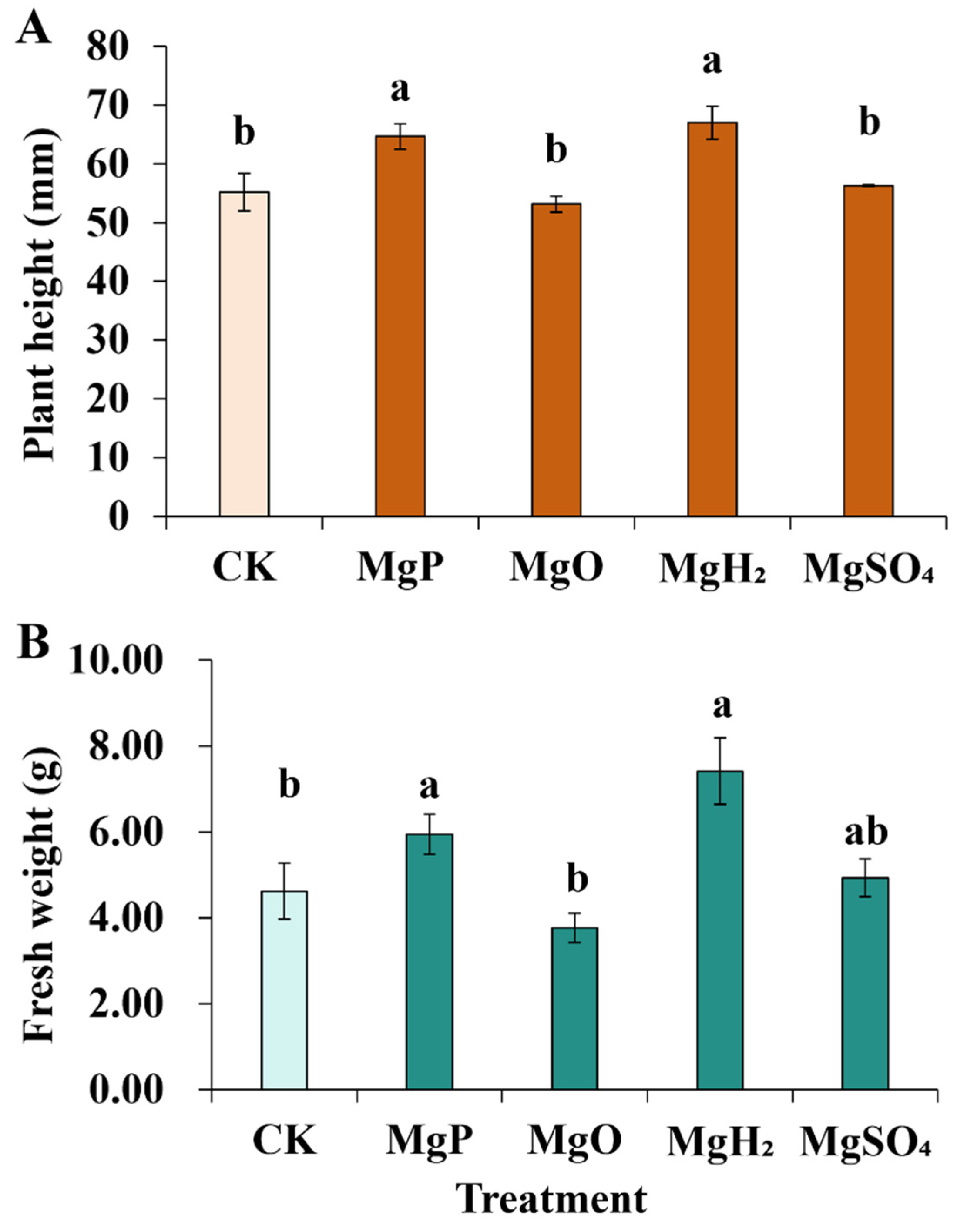
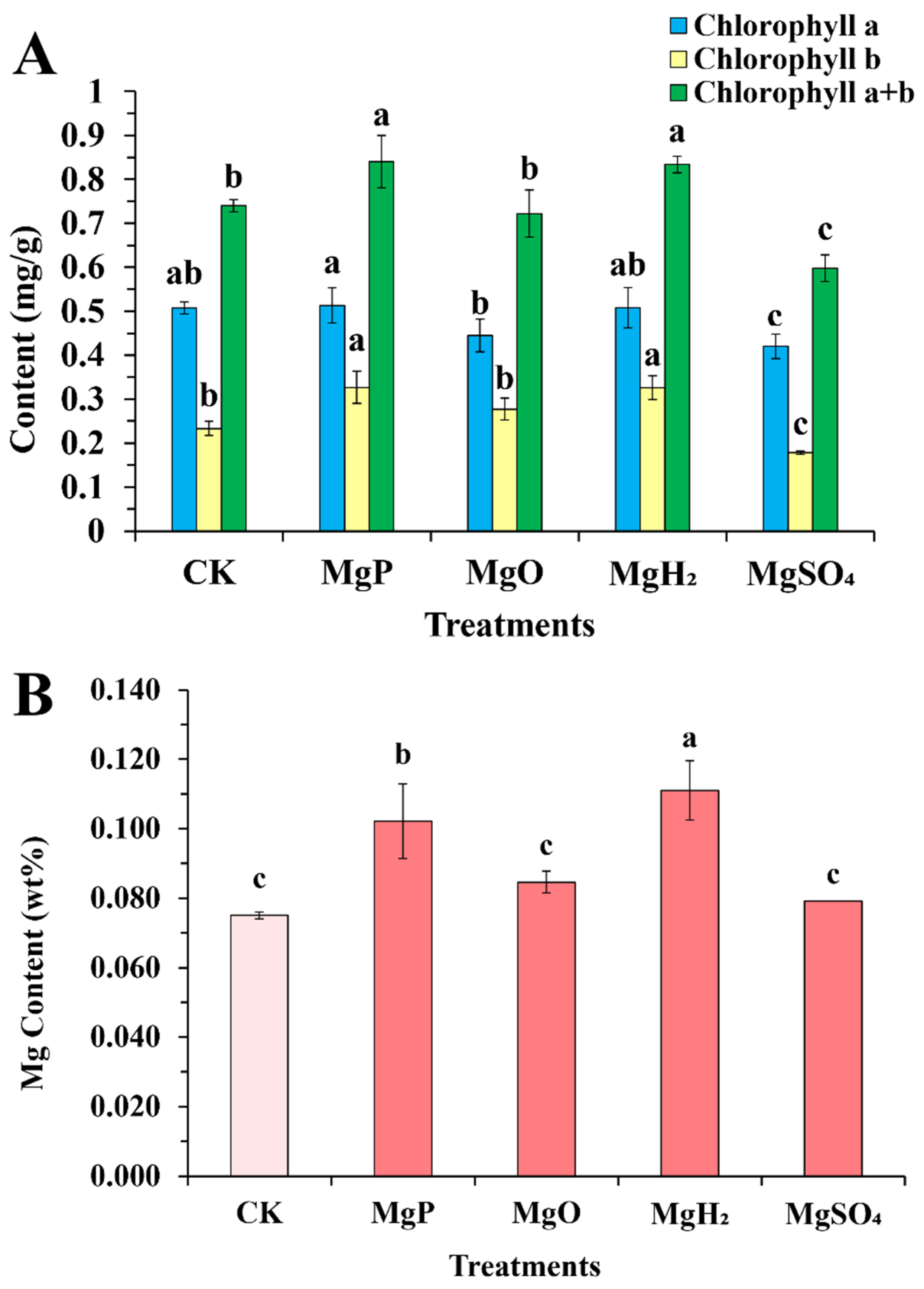
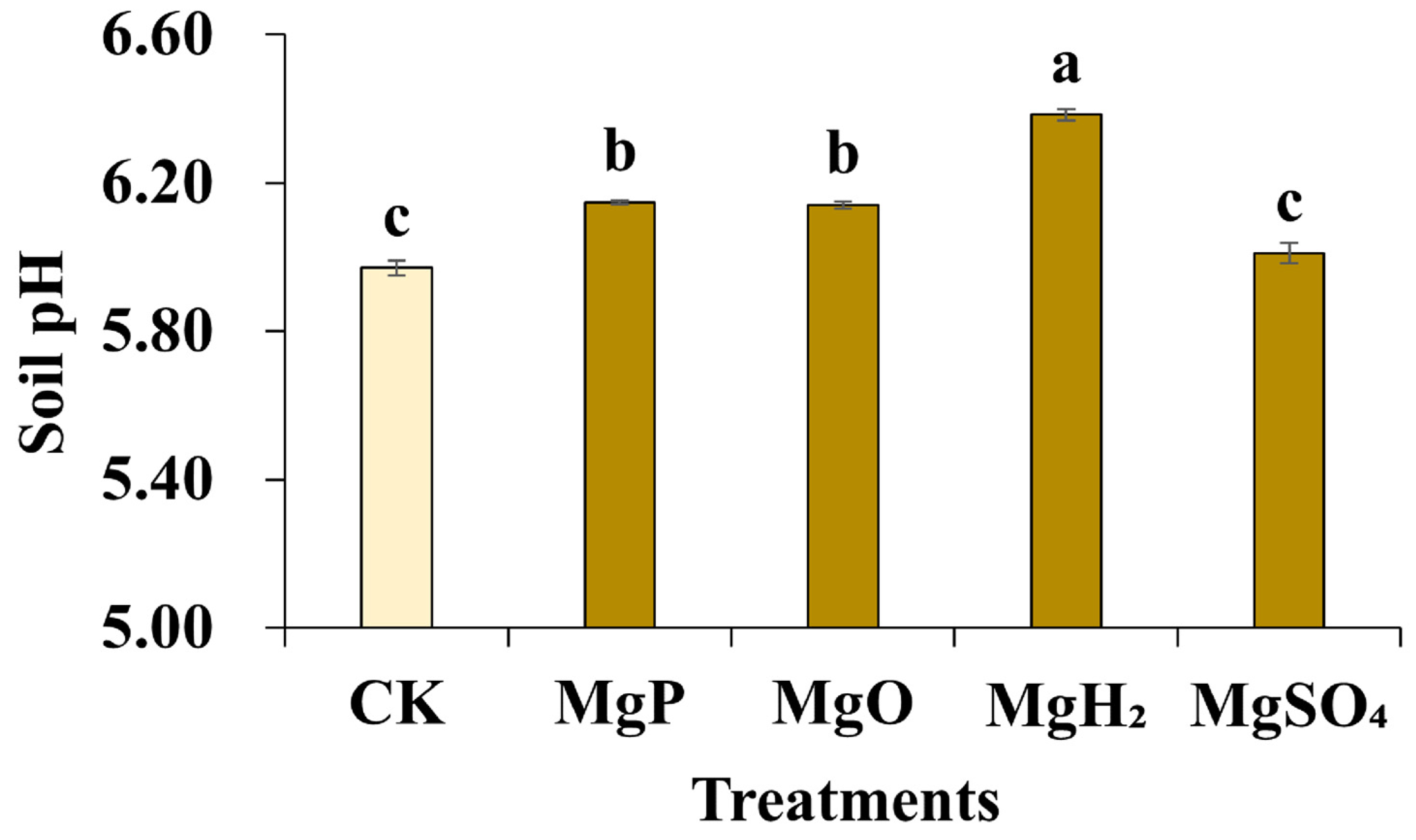
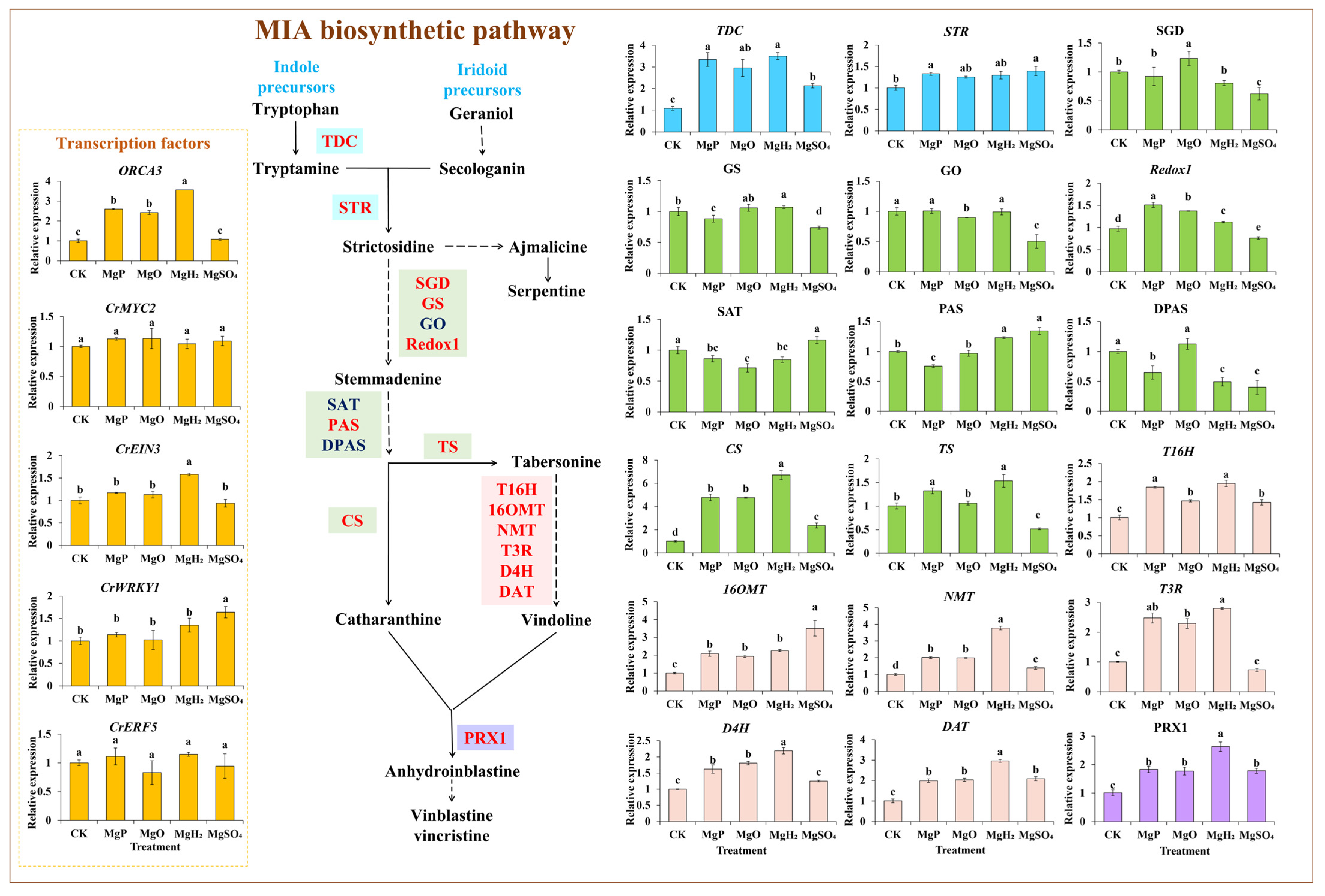
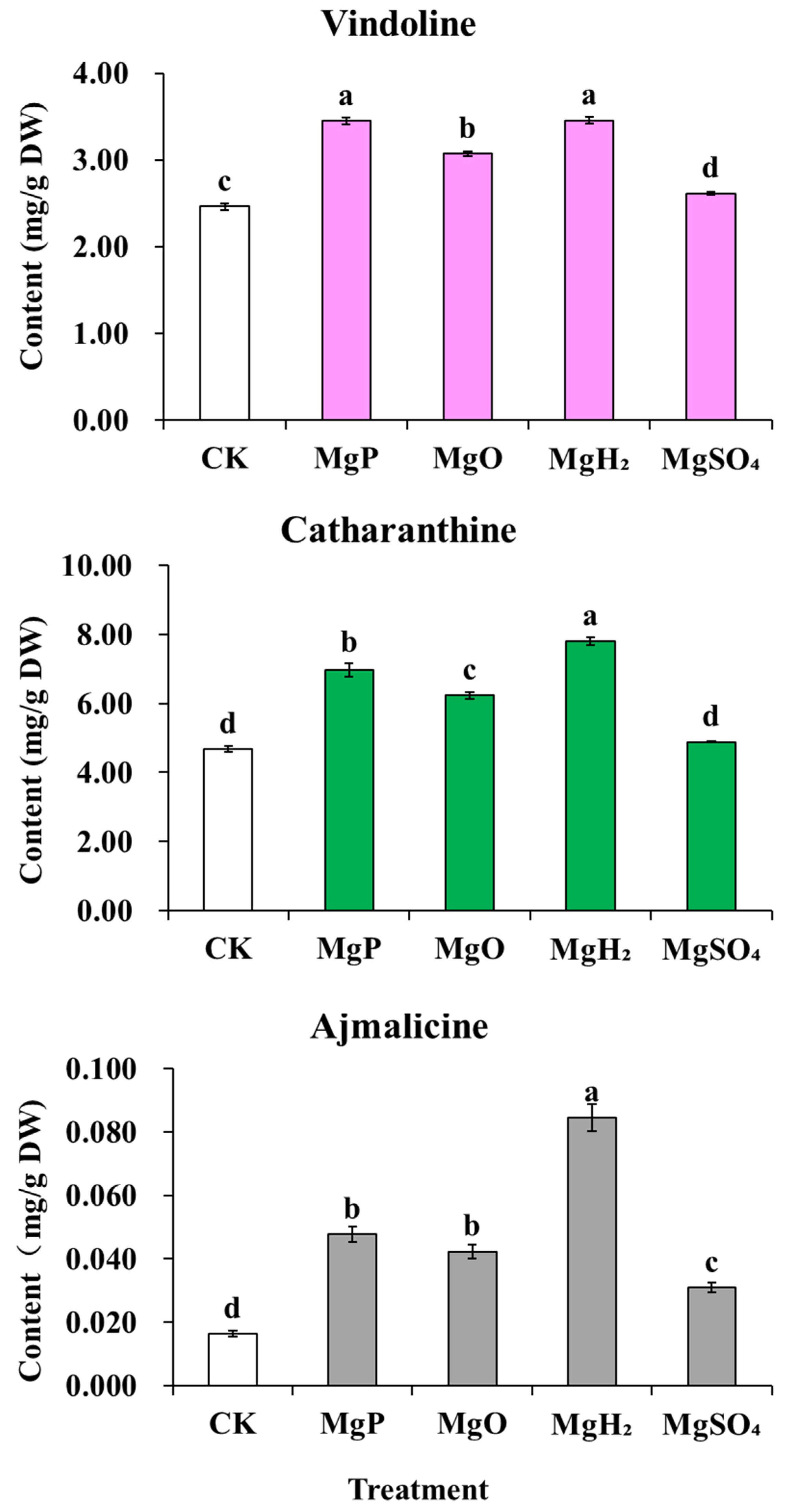
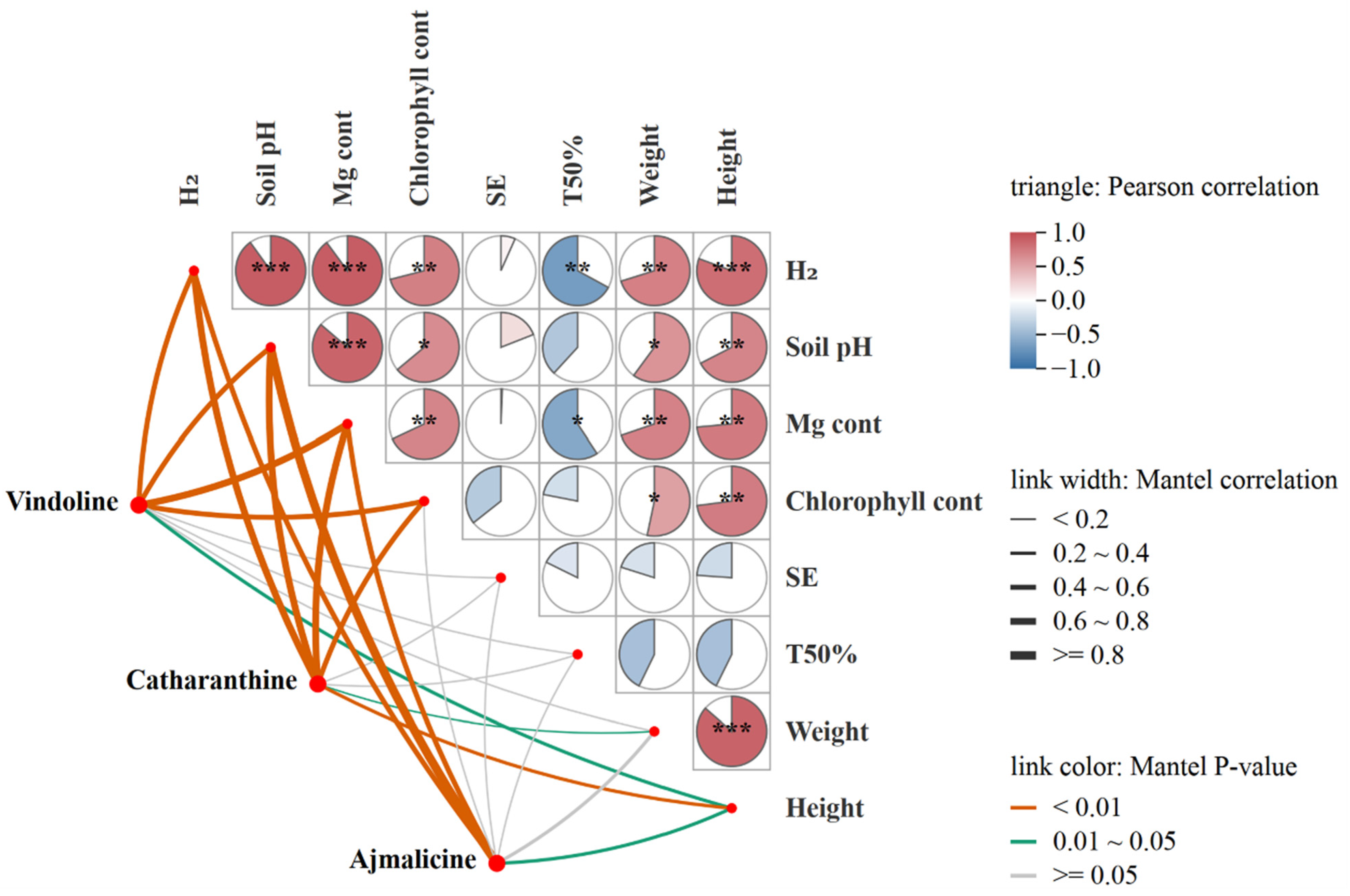

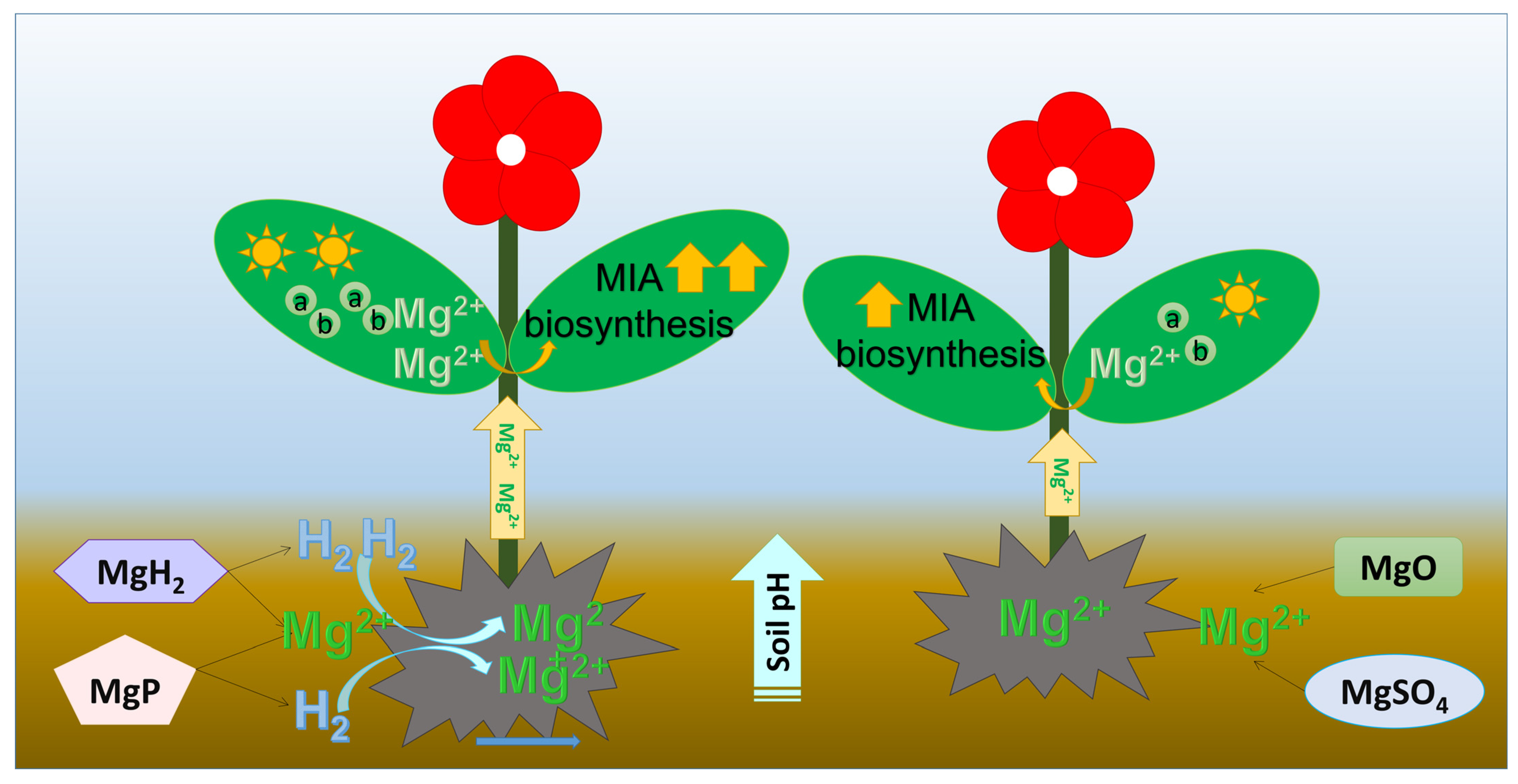
| Treatment | Seedling Emergence % | Time for 50% Emergence (Days) |
|---|---|---|
| CK | 87.69 ± 0.27 a | 4.65 ± 0.07 ab |
| MgP | 88.01 ± 0.33 a | 4.50 ± 0.05 bc |
| MgO | 90.75 ± 0.27 a | 4.76 ± 0.12 a |
| MgH2 | 90.67 ± 1.80 a | 4.46 ± 0.01 c |
| MgSO4 | 91.82 ± 2.21 a | 4.58 ± 0.12 bc |
Disclaimer/Publisher’s Note: The statements, opinions and data contained in all publications are solely those of the individual author(s) and contributor(s) and not of MDPI and/or the editor(s). MDPI and/or the editor(s) disclaim responsibility for any injury to people or property resulting from any ideas, methods, instructions or products referred to in the content. |
© 2025 by the authors. Licensee MDPI, Basel, Switzerland. This article is an open access article distributed under the terms and conditions of the Creative Commons Attribution (CC BY) license (https://creativecommons.org/licenses/by/4.0/).
Share and Cite
Ou, C.; Qiu, X.; Zhao, Q.; Ding, D.; Zhang, Y.; De, J.; Wang, Y.; Tang, K.; Yang, H.; Pan, Q. Magnesium Plus Hydrogen Fertilization Enhances Mg Uptake, Growth Performance and Monoterpenoid Indole Alkaloid Biosynthesis in Catharanthus roseus. Plants 2025, 14, 3336. https://doi.org/10.3390/plants14213336
Ou C, Qiu X, Zhao Q, Ding D, Zhang Y, De J, Wang Y, Tang K, Yang H, Pan Q. Magnesium Plus Hydrogen Fertilization Enhances Mg Uptake, Growth Performance and Monoterpenoid Indole Alkaloid Biosynthesis in Catharanthus roseus. Plants. 2025; 14(21):3336. https://doi.org/10.3390/plants14213336
Chicago/Turabian StyleOu, Chaoqin, Xinmin Qiu, Qian Zhao, Ding Ding, Yaojie Zhang, Ji De, Yuliang Wang, Kexuan Tang, Haiyan Yang, and Qifang Pan. 2025. "Magnesium Plus Hydrogen Fertilization Enhances Mg Uptake, Growth Performance and Monoterpenoid Indole Alkaloid Biosynthesis in Catharanthus roseus" Plants 14, no. 21: 3336. https://doi.org/10.3390/plants14213336
APA StyleOu, C., Qiu, X., Zhao, Q., Ding, D., Zhang, Y., De, J., Wang, Y., Tang, K., Yang, H., & Pan, Q. (2025). Magnesium Plus Hydrogen Fertilization Enhances Mg Uptake, Growth Performance and Monoterpenoid Indole Alkaloid Biosynthesis in Catharanthus roseus. Plants, 14(21), 3336. https://doi.org/10.3390/plants14213336






